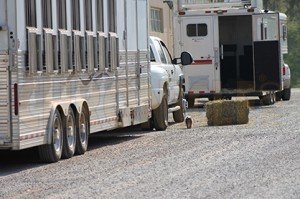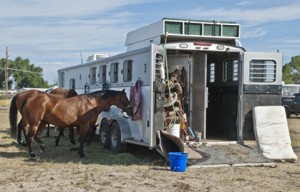Are You Prepared For Winter? Part 2: Winterizing Your Horse Trailer
By: Megan Arszman
For some, the colder temperatures signal the start of hibernation—it might be for just a few weeks of vacation after the hustle and bustle of the year-end shows are complete, or for a few months of an extended break until the days get longer and brighter. However you choose to celebrate winter, you want to make sure your expensive equipment, horse, and maybe even yourself, is prepared to handle the weather and be ready to hop back into work when the time comes.
One of your biggest investments is your horse trailer, and when it comes to storage, it’s important to understand what you need to do to protect that investment. Properly winterizing your horse trailer will provide it with a longer working life, as well as a potentially higher resale value, should you decide to sell it down the road. It is best to talk to your dealer about any specific requirements needed to store your trailer in your geographic area.
1. Clean out the trailer. It may seem obvious, but this means stripping the bedding from the animal portion in the back, emptying out your tack compartment, and cleaning out the living quarters area. Sweep out the remains of sawdust and manure, ensuring there aren’t any remnants that can fall down in the springs of your doors or drop down ramp. An air compressor is helpful for blowing stray particles out of hay mangers and springs.
If the weather allows, take out the rubber mats and use a pressure washer to hose them down. Also, clean the inside of the animal portion of the trailer and ensure that everything is dry before replacing it. Remove all food from the living quarters, and properly store grooming supplies and tack for the winter season.
2. Assess rust. Don’t let that tiny rust spot grow into a larger problem. Using a sander or wire brush, remove rust from the trailer (inside and out). Then, thoroughly clean the area. Once dry, paint the affected area with rust-inhibitor paint. Places to pay attention for potential rust include the frame of the trailer (particularly where the sidewall meets the floor), axles, framework on the tongue (for bumper pulls), and the undercarriage. FYI: Both aluminum and steel trailers are affected by rust.
3. Protect the tires. If you’re storing your trailer outside, invest in some tire covers, or at least put a coat of rubber protectant on your tires to limit exposure to sun and the elements—tires can go bad from just sitting around. The standard recommendation is to move your trailer at least once a month, or put it on blocks to prevent the tires from flattening on the ground side.
4. Shut down the living quarters. Make sure all switches are turned off, electronics are unplugged, and curtains and blinds are closed. Lakota Trailers suggests protecting curtains from fading in the sun by placing aluminum foil or paper between the window and the screen. Also, check that all vents are properly closed—you can cover exterior vents on appliances to prevent moisture and insects from entering the trailer during downtime.
5. Check the battery power. According to Lakota Trailers, it’s best to make sure your trailer’s battery (if you have one) has the proper electrolyte level and is fully charged. If the battery is discharged, it can freeze and crack the case, which can ruin the battery. When your trailer is stored, a battery can gradually lose charge over a 30-45 day period, even if it’s disconnected. Check your battery once a month during storage. (You can remove the battery from the trailer and store in a heated area, but still maintain the charge level.)












